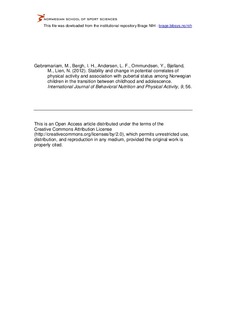| dc.contributor.author | Gebremariam, Mekdes K. | |
| dc.contributor.author | Bergh, Ingunn Holden | |
| dc.contributor.author | Andersen, Lene F. | |
| dc.contributor.author | Ommundsen, Yngvar | |
| dc.contributor.author | Bjelland, Mona | |
| dc.contributor.author | Lien, Nanna | |
| dc.date.accessioned | 2012-11-14T13:14:34Z | |
| dc.date.available | 2012-11-14T13:14:34Z | |
| dc.date.issued | 2012-05-11 | |
| dc.identifier | Seksjon for coaching og psykologi / Department of Coaching and Psychology | |
| dc.identifier.citation | International Journal of Behavioral Nutrition and Physical Activity. 2012, 9, 56 | no_NO |
| dc.identifier.issn | 1479-5868 | |
| dc.identifier.uri | http://hdl.handle.net/11250/171010 | |
| dc.description | © 2012 Gebremariam et al.; licensee BioMed Central Ltd. | no_NO |
| dc.description.abstract | Background
Whereas tracking and change in physical activity (PA) in children and adolescents have been well documented, studies investigating these patterns in its correlates are lacking. The present study aims to address this gap and in addition explore the impact of pubertal status on PA and its potential psychological and social-environmental correlates in a sample of Norwegian children over a 20-month period.
Methods
A total of 885 students from 25 control schools of an intervention study, the HEalth In Adolescents (HEIA) study were included (mean age at baseline 11.2 (0.3)). The baseline took place in September 2007, the first follow-up in May 2008 and the second follow-up in May 2009. PA and its potential correlates (enjoyment of PA, self-efficacy related to barriers to PA, perceived support for PA from parents, friends and teachers, perceived social inclusion and perceived environmental opportunities for PA) were self-reported. Pubertal status was assessed using the Pubertal Development Scale. Repeated-measures ANOVA was used to explore changes. Tracking was assessed using Spearman’s rank order correlation. Pubertal groups were compared using ANOVA or ANCOVA (controlling for BMI). Multiple regression analyses were used to investigate whether pubertal stage at age 11 would predict levels of correlates and PA at age 13.
Results
Potential correlates of PA and the behaviour itself were found to track moderately in the transition between childhood and adolescence. Small but significant changes in enjoyment of PA and teachers’ support for PA in both genders and in friends’ support for PA and perceived environmental opportunities for PA in females in a direction unfavourable to PA were detected. A few weak positive associations between pubertal stage and correlates of PA at age 11 were noted among boys.
Conclusions
Enjoyment of PA, self-efficacy related to barriers to PA, perceived social support for PA, perceived social inclusion, perceived environmental opportunities for PA and the behaviour itself were found to be moderately stable in the transition between childhood and adolescence. Health promotion efforts in childhood targeting PA and its psychosocial and social-environmental correlates might have favourable effects in later years. | no_NO |
| dc.language.iso | eng | no_NO |
| dc.publisher | BioMed Central | no_NO |
| dc.subject | adolescents | no_NO |
| dc.subject | physical activity | no_NO |
| dc.subject | correlates | no_NO |
| dc.subject | puberty | no_NO |
| dc.subject | tracking | no_NO |
| dc.subject | change | no_NO |
| dc.title | Stability and change in potential correlates of physical activity and association with pubertal status among Norwegian children in the transition between childhood and adolescence. | no_NO |
| dc.type | Journal article | no_NO |
| dc.type | Peer reviewed | no_NO |
| dc.subject.nsi | VDP::Social science: 200::Social science in sports: 330 | no_NO |
| dc.subject.nsi | VDP::Medical disciplines: 700::Sports medicine: 850 | no_NO |
| dc.source.pagenumber | 56 | no_NO |
| dc.source.volume | 9 | no_NO |
| dc.source.journal | International Journal of Behavioral Nutrition and Physical Activity | no_NO |
